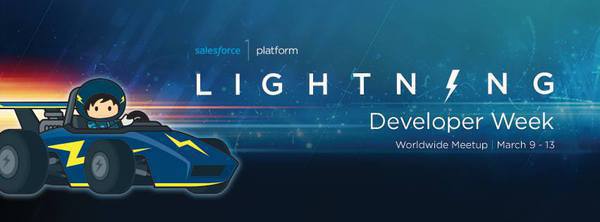It was back to the splendid Salesforce Tower, Liverpool Street, for September’s London Salesforce DUG. The standard fayre of beer and pizza (and Coconut milk, for those that fancied it) was available, so let’s thank Salesforce for the venue and Westbrook for the sustenance.

Photo: Anup Jadhav – London Salesforce DUG
Lightning was once again on the menu, and I wonder if we’ll ever again have a DUG or AUG that has a lightning-free line-up. But let’s make no mistake, Lightning is still evolving, so these talks are just as needed and as interesting as ever.
Advanced Designs for Reusable Lightning Components – Tom Waud
As well as sponsoring the event, Westbrook also represented in the talks, with CTA Tom Waud kicking off the night. He presented a run through of some useful design patterns and approaches that can be considered when looking to reduce code duplication when building Lightning components. He also covered some clever handling of some of the nuances that currently exist with the framework. This talk was actually the one that Tom will (has) presented at Dreamforce ‘16… and if you do (have) caught it there then I’m sure you’ll be glad you did.
Tom’s talk focused around a Job Scheduler component that he has written, and he used this as a reference throughout. The approach made it very easy to relate the concepts he spoke about to real life implementations and challenges. The code for the scheduler can be found in Tom’s git repo.
Tom covered a variety of aspects including;
- Composition using Facets – Including the aura:set and Event Bubbling (including a Winter ‘17 improvement called includeFacets
- Dynamic Creation of Components
- Object Orientation – Encapsulation + inheritance, and some of the current limitations and workarounds.
It is clear that Lightning is still evolving with every release of Salesforce, and it seems that, despite some good fixes coming in with the Winter ‘17 release, some of the missing/broken parts are still a barrier-too-far for many ISVs and consultancies alike. With this in mind though, it was also good to see John Belo – Director of ISV Technical Enablement, EMEA – ask Tom (and the audience) how Salesforce can improve Lightning for developers and what could be done to increase its adoption.
Tom’s slides can be found here.
Winter 17 Lightning Release, Highlights for Developers – Laura Kulikauskaite
As the newest Associate ISV Technical Evangelist, Laura was at the DUG to talk us through some of the changes to Lightning in Winter ‘17, and how these changes affect and can be used by developers.
The first thing that she mentioned was a new Winter ‘17 Lightning Trailhead module, so if you’re dabbling with Lightning (or using it in production) then it would be good to check out.
As well as the fixes and improvements that Tom mentioned in his earlier talk, Laura covered some nice new enhancements to Lightning. These include;
- Custom Lightning App, with custom Lightning navigation bar
- App Launcher available in the access menu
- Utility Bar – Currently only available to ISV partners. Should be available for all users in the Spring ‘17 release
Laura also covered the release of many more base Lightning components (icons, badges, inputs, etc) as well the support for Quick Actions.
Another new feature, that apparently has been highly demanded by users, is Inline Editing in Listviews. I remember a breakfast-meet back in January ‘16 at Salesforce Tower (before it was kinda-called Salesforce Tower) where this idea was originally spoken about. Diego Ferriro Val – Software Engineer/Architect Lighting – spoke about how Inline editing can quickly lead to a huge increase in transactions to the platform, as each edit could kick off a save event. In the actual approach demonstrated at the DUG the list remains in an at-risk state, with edits highlighted. A Save button actually needs to be clicked for the edit to be sent to Salesforce. Whilst this approach does get over the risk of adding unnecessary load to the platform, it does potentially mean that these at-risk edits could be lost, if for example, the user’s laptop ran out of battery, or crashed. Perhaps Salesforce are using a more persistent local store for these edits to combat this, though this was not covered in the demo. Within the MobileCaddy apps we take an offline-first view on these types of actions, and we would be using the persistent encrypted local store for all edits, so as to reduce any real at-risk records.
A demo of the Lightning App Builder was also on the menu, and I have to say I still noted Lightning to be pretty slow. I’m sure work on improving this is ongoing, but personally I think the current performance is going to irk users who are using LEX. And I might be wrong but doesn’t the screenshot below look like a classic list view (yes this is my Summer ‘16 dev org, but still looks the same in Winter ‘17)?

During the questions, the point of unit tests within Lightning was raised. We were told that these are planned for Spring ‘17. I’m sure this will make many developers much happier.
Wrap up
It was another truly interesting DUG, and I really must thank Anup Jadhav and Jodi Wagner for organising and Westbrook and Salesforce for sponsoring and hosting.
It’s good to see the evolution of Lightning, though it is very clear from chatting to other attendees that adoption is still slow.










